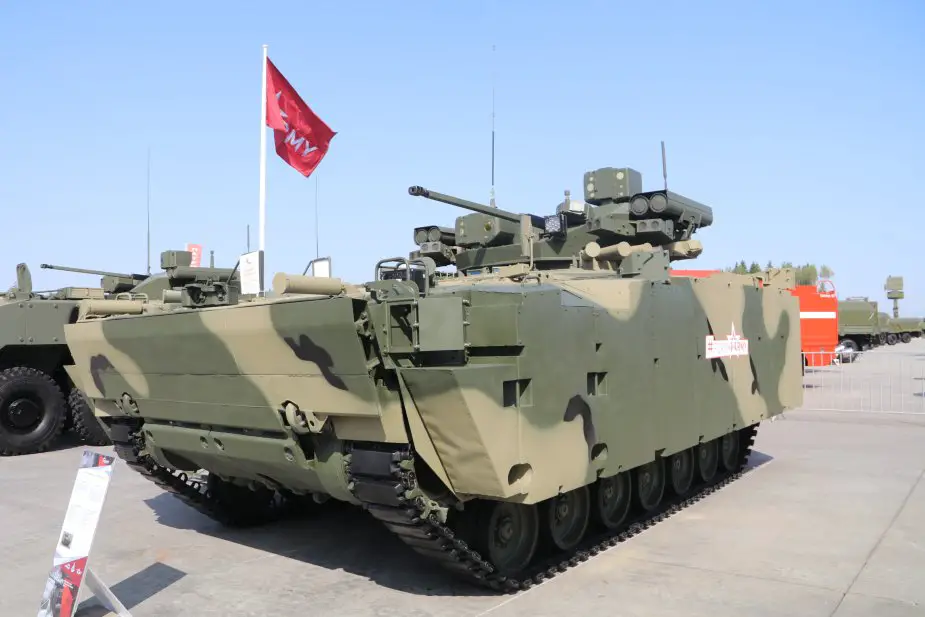In 2018, the first batch of modernized BMP-2M infantry fighting vehicles arrived for service with the Russian army. It looks like the Russian Defense Ministry has determined how the 3,500 BMP-2 infantry fighting vehicles currently in service would be upgraded. If the tests of the 16 acquired machines prove successful, the bulk of the BMP-2 inventory will get new lease of life, the Military-Industrial Courier newspaper reports.

Kurganets 25 (Picture source: Army Recognition)
The BMP B-11 IFV based on the Kurganets-25 platform is just only undergoing acceptance trials. Complete arming of the armed forces with these machines is a matter of a future decade. The situation is similar with machines on the Armata platform. So, in the 2020s, the BMP-2s will still be the core of motorized rifleman units, and then will remain standby vehicles in the event of a major conflict. Under such circumstances, the BMP-2s will not leave the Russian armed forces in the foreseeable future provided their modernization succeeds. It includes four simple constituents, one of which is installation of the Berezhok combat module. This is very similar to the former BMP-2 turret, except the 30mm standard cannon and 7.62mm twin PKT machinegun. Also, it is armed with four Kornet ATGW and remotely controlled AGS-17 grenade launcher. The vehicle has a new fire control system (FCS) and modern surveillance equipment. The gun layer has received a combined sight with stabilization in two planes. In addition, the equipment includes optic devices, thermal imager, laser range-finder plus Kornet missile guidance channel. The Berezhok FCS is fitted with an armament stabilizer and automatic target tracking system. Installation of a new UDT-23 370 hp engine makes the vehicle more agile. The worn-out components have been replaced. Obviously, the BMP-2 is an excellent but rather obsolete vehicle. In terms of modern technologies, the BMP-2 is very poorly protected. Its repair is labor-intensive, and its surveillance equipment lags behind times.
Therefore, the upgrading of this machine is by far not a trivial task. Not all technical solutions will work here. Naturally, the modernization should start with giving the machine adequate surveillance systems. Here, the situation is more or less clear - the important thing is to provide, at a reasonable cost, an all-weather operating capability and maximum target detection range. Other solutions, however, are not simple. The very poor protection is cured with difficulty. At different times attempts were made to affix explosive reactive armor and anti-cumulative shields. True, the survivability improved, but the BMP-2 thus was losing its floating capability. That was what the military was unwilling to part with for understandable reasons.
An unobvious way of improving the machine’s survivability on the battlefield is providing it with higher firing power. So, the BMP will be able to stay further away from the enemy and fire from a distance insurmountable by such weapons as large caliber machineguns, hand-held and mounted grenade launchers, and even 25mm automatic cannons, the main armament of the US Bradley IFV. That was the route taken by developers of BMP-3, a machine not radically different from the BMP-2 in terms of protection, but capable of keeping a foe at a safe distance thanks to its 100mm cannon.
Attempts were made to arm the BMP-2 with Bakhcha-U combat module from the BMP-3. This resulted in a "reduced-weight" version of the BMP-3, with landing section slimmed to 5 men, lost buoyancy, and the self-same thin-walled hull. In addition, the Bakhcha combat module is a fairly expensive piece of equipment.
The combat module Berezhok looks altogether different. It does not increase the vehicle weight and takes up little precious space. At the same time, it provides an array of useful capabilities. The Kornet ATGW has long been used exclusively against tanks. The ammunition package includes the 9M133F high-explosive, and 9M133FM-3 and 9M133FM-2 thermobaric missiles for neutralizing sheltered enemy infantry, as well as 9M133FM-3 rounds for engaging low-flying targets. Naturally, the BMP-2M can also repel the enemy armor, including even modern tanks. And all this at a distance of 5 km.
The enemy infantry will not easily come close to the BMP-2M. The AGS-17 grenade launcher mounted on the turret with an ammunition supply of 300 rounds is a serious weapon, each of whose grenade ensures an area of solid destruction with a diameter of nearly 8 meters. The main weapon, 30mm 2A42 should not be ignored, either.
The BMP-2M has nothing to do in an urban engagement. Expressly for this purpose the heavy BMP T-15 vehicle is being created. Also, the BMP-2M should not be used in mountain warfare where special units must be employed, duly trained and equipped. In all other cases, the BMP-2M can be extremely useful.
Of course, the BMP-2M is a compromise (probably, the only possible one in the current situation) between combat efficiency and cost. Of late, the Defense Ministry has generally demonstrated commendable wisdom in upgrading the armor left over from the former USSR, the Military-Industrial Courier newspaper writes.














